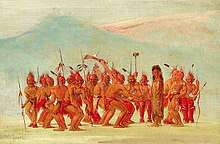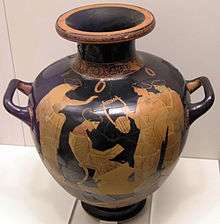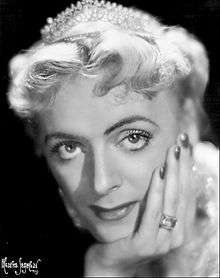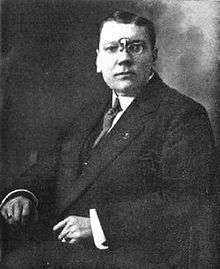Transgender history
Transgender history dates back to the first recorded instances of transgender individuals in ancient civilizations in Asia.
Ancient history
Africa
Egypt
Inscribed pottery shards from the Middle Kingdom of Egypt (2000–1800 BCE), found near ancient Thebes (now Luxor, Egypt), list three human genders: tai (male), sḫt ("sekhet") and hmt (female).[1] Sḫt is often translated as "eunuch", although there is little evidence that such individuals were castrated.[2] In the Eighteenth Dynasty of Egypt, Queen Hatshepsut became pharaoh and was believed to wear male clothing and a false beard. [3] Many existing statues alternatively show her in typically feminine attire as well as those that depict her in the royal ceremonial attire. Statues portraying Sobekneferu also combine elements of traditional male and female iconography and, by tradition, may have served as inspiration for these works commissioned by Hatshepsut.[4]
Uganda
Uganda has a long and, until relatively recently, quite permissive LGBT history. During precolonial times, Religious roles for cross-dressing men (homosexual priests) were historically found among the Bunyoro people. The Teso people also acknowledged a category of men who dressed as women.[5]
Americas

Prior to western contact, some American Native tribes had third-gender roles, but details were only recorded after the arrival of Europeans. Roles included "berdache" (a derogatory term for people who were assigned male at birth, who assumed a traditionally feminine role) and "passing women" (people who were assigned female at birth who took on a traditionally masculine role). The term "berdache" is not a Native American word; rather it was of European origin and covered a range of third-gender people in different tribes. Not all Native American tribes recognized transgender people.[6]
One of the first accounts of transgender people in the Americas was made by Jesuit missionary Joseph-François Lafitau who spent six years among the Iroquois in 1711.[7] He observed "women with manly courage who prided themselves upon the profession of warrior" as well as "men cowardly enough to live as women."[8]
Asia
In ancient Assyria, there were homosexual and transgender cult prostitutes, who took part in public processions, singing, dancing, wearing costumes, sometimes wearing women's clothes and carrying female symbols, even at times performing the act of giving birth.[9]
In ancient India, Hijra are a caste of third-gender, or transgender group who live a feminine role. Hijra may be born male or intersex, and some may have been born female.[10] Hijras have a recorded history in the Indian subcontinent from antiquity onwards as suggested by the Kama Sutra period.
In Persia, poets such as Sa'di, Hafiz, and Jami wrote poems replete with homoerotic allusions, including sex with transgender young women or males enacting transgender roles exemplified by the köçeks and the bacchás, and Sufi spiritual practices.
Europe
Ancient Greece

In Ancient Greece and Phrygia, and later in the Roman Republic, the Goddess Cybele was worshiped by a cult of people who castrated themselves, and thereafter took female dress and referred to themselves as female.[11][12] These early transgender figures have also been referred by several authors as early gay role models.[13][14]
Ancient Rome
Modern period
This covers roughly the period from The Enlightenment to today.
Africa
South Africa
On March 15, 2004 – The Alteration of Sex Description and Sex Status Act, 2003 comes into force, allowing transgender and intersex people to change their legally recognized sex. [15]
Botswana
In September 2017, the Botswana High Court ruled that the refusal of the Registrar of National Registration to change a transgender man's gender marker was "unreasonable and violated his constitutional rights to dignity, privacy, freedom of expression, equal protection of the law, freedom from discrimination and freedom from inhumane and degrading treatment". LGBT activists celebrated the ruling, describing it as a great victory.[16][17] At first, the Botswana Government announced it would appeal the ruling, but decided against it in December, supplying the transgender man with a new identity document that reflects his gender identity.[18]
A similar case, where a transgender woman sought to change her gender marker to female, was heard in December 2017. The High Court ruled that the Government must recognise her gender identity.[19] She dedicated her victory to "every single trans diverse person in Botswana".
Americas
Mexico
In Zapotec cultures of Oaxaca a muxe is an individual assigned male at birth who dresses and otherwise behaves in ways associated with females. They may be seen as a third gender.[20] Muxe may do certain kinds of women’s work such as embroidery but others do the male work of making jewelry.[21][22] One study estimates that six percent of males in an Isthmus Zapotec community in the early 1970s were muxe.[23]
United States of America

There were isolated cases of people living as the opposite gender in the early years of the Republic such as Joseph Lobdell. During the Civil War, over 200 women donned men's clothing and fought as soldiers; some were transgender and lived the rest of their lives as men, such as Albert Cashier.[24]
In 1895 a group of self-described androgynes in New York organized a club called the Cercle Hermaphroditos, based on their wish "to unite for defense against the world's bitter persecution".[25]
A couple of first-person accounts in the early years of the 20th century cast some light on what life for a transgender person was like then, including The Autobiography of an Androgyne (1918) by Jennie June (born in 1874 as Earl Lind).[26] Notable American jazz musician and bandleader Billy Tipton (born in 1914 as Dorothy Lucille Tipton) lived as a man from the 1940s until his death.[27]
The idea of someone changing sex was unknown to most people until news about Christine Jorgensen burst onto the scene in 1952. She was the first widely publicized person to have undergone sex reassignment surgery.[28] Around the same time, organization and clubs began to form, such as Virginia Prince's Tranvestia publication for an international organization of cross-dressers,[29] but this operated in the same shadows as did the still forming gay subculture. In the 1960s, transgender and gay activism began with riots in 1966 at Compton's Cafeteria in San Francisco and in a defining event in gay and transgender activism, the 1969 Stonewall Riots in New York.
The 1970s and 1980s saw organizations devoted to transgender social activities or activism come and go, including activist Lou Sullivan's FTM support group that grew into FTM International, the leading advocacy group for female-to-male transgender individuals.[29] Some feminist and lesbian organizations and individuals began to question whether transgender individuals could be accepted in events designated for one sex only, such as the women's music collective Olivia Records where trans woman Sandy Stone had long been employed, or in the 1990s at the Michigan Womyn's Music Festival which had a "women-born-women" in policy.
Among Native Americans, the term Two Spirit was adopted in 1994 with general, though not universal agreement among various tribes to refer to third gender or gender-variant individuals in their communities.[30]
The 1990s saw the establishment of Transgender Day of Remembrance to honor those lost to violence, transgender marches and parades around the time of Gay Pride celebrations and increasingly in the 2000s and after, the visibility of transgender individuals rose, along with actresses like Laverne Cox who was on the cover of TIME[31][32][33] and exemplified by Caitlyn Jenner coming out in 2015.[34] Many news sources have described Jenner as the most famous openly transgender American.[35][36][37]
Organizations such as the Girl Scouts[38] and the Episcopal Church announced acceptance of transgender people[39] in the 2010s. In 2016, the Obama administration issued guidance that clarified Title IX protections for transgender students. This letter included definitions of terminology and clarified the rights of transgender students, the most well-known being allowance of transgender students to use bathrooms and locker rooms matching their gender identity.[40] However, some legislative bodies took up bills seen as discriminatory, such as North Carolina's HB 2. The Obama administration's guidance for protection of transgender students was rescinded in early 2017 by the Trump administration.[41]
Hawaii became the first state to elect an openly transgender woman to statewide office when Kim Coco Iwamoto was elected to the Hawaii Board of Education in 2006, and later as commissioner on the Hawaii Civil Rights Commission in 2012.[42]
In 2017, Danica Roem became the first openly transgender woman to be elected to a state legislature in the state of Virgina, defeating 12-term Republican incumbent Bob Marshall by 7.83 percentage points[43].
Canada
During the colonial period in Canada a European system of beliefs and values was virtually imposed on the First Nations. As part of this enterprise, missionaries made some of the first observations of LGBT practices among native populations. Jesuit Joseph-François Lafitau spent six years among the Iroquois starting in 1711 where he made important discoveries about Iroquois society.[7] About his observations of cross-gender behavior he later wrote, "If there were women with manly courage who prided themselves upon the profession of warrior, which seems to become men alone, there were also men cowardly enough to live as women."[8]
In 1738 The arrival of Esther Brandeau, a young Jewish woman disguised as a boy and using the male pseudonym Jacques La Fargue, caused a minor scandal in Quebec City.[44]
In 2002, sexual orientation and gender identity were included in the Northwest Territories Human Rights Act.
In February 2011, the House of Commons passed at third reading NDP MP Bill Siksay's Bill C-389, to amend the federal Canadian Human Rights Act to include gender identity and gender expression as prohibited grounds of discrimination under Canadian federal anti-discrimination laws, at third reading, but it died on the order paper in the Senate when Parliament was dissolved. The bill was reintroduced as Bill C-279 in the subsequent Parliament and passed second reading on June 6, 2012. June 2012 also saw the addition of gender identity and gender expression to the Ontario Human Rights Code and of gender identity to the Manitoba Human Rights Code.
May 19 2012: following a legal battle to reverse her disqualification for not being a "naturally born female", Vancouver resident Jenna Talackova successfully became the first transgender woman to compete in a Miss Universe pageant.[45] She does not make the Top 5, but is one of four contestants awarded the title of "Miss Congeniality".[45]
On December 6, 2012 Bill No. 140 of the 61st General Assembly of Nova Scotia known as the Transgendered Persons Protection Act was given Royal Assent by the then Lieutenant Governor of Nova Scotia Mayann Francis. It added both gender identity and gender expression to the list of things explicitly protected from harassment in the province's Human Rights Act.[46]
On March 20 2013, - The House of Commons passed Bill C-279, a private member's bill sponsored by Randall Garrison, which officially extends human rights protections to transgender and transsexual people in Canada.[47] The bill passes with virtually unanimous support on the opposition benches, as well as 18 members of the governing Conservative Party caucus, although the majority of Conservatives are opposed.[47]
On February 25 2015 - The Senate of Canada amends Bill C-279, the transgender equality bill passed by the House of Commons of Canada in 2013, in ways which are criticized as transphobic.[48]
December 1 - During debate in the Legislative Assembly of Alberta on the inclusion of gender identity as protected grounds in the provincial Human Rights Code, MLA Estefania Cortes-Vargas was represented in media coverage during the election campaign as female and lesbian,[49] in December 2015 they formally came out as non-binary in the legislature during debate on the inclusion of transgender rights in the provincial human rights code.[50] While the provincial Hansard normally reports members' speeches under the gender honorifics "Mr." or "Ms.", Cortes-Vargas is recorded as "Member Cortes-Vargas".[50] >
December 17 - Kael McKenzie was appointed to the Provincial Court of Manitoba, becoming Canada's first-ever transgender judge.[51]
In 2016, gender identity or expression was added to Quebec Charter of Rights and Freedoms, which is both a charter of rights and a human rights act.
January 21 2016 - Through her foundation, Jennifer Pritzker gave a $2 million donation to create the world’s first endowed academic chair of transgender studies, at the University of Victoria in British Columbia; Aaron Devor was chosen as the inaugural chair.[52]
May 17 2016 - Federal Minister of Justice Jody Wilson-Raybould introduces Bill C-16, which will update the Canadian Human Rights Act and the Criminal Code to include "gender identity and gender expression" as protected grounds from discrimination, hate publications and advocating genocide. The bill will also add "gender identity and expression" to the list of aggravating factors in sentencing, where the accused commits a criminal offence against an individual because of those personal characteristics.[53] Although the New Democratic Party had introduced similar private member's bills several times in previous years, C-16 represents the first time such a bill has been put forward by the governing party in the House of Commons.[53]
Since June 2017, all places within Canada explicitly within Canadian Human Rights Act, equal opportunity and/or anti-discrimination legislation prohibit discrimination against gender identity or gender identity or expression.[54]
As of August 31, 2017, Canadians can indicate that they do not identify as male or female on their passports. This is an ongoing effort by the federal government to eventually allow individuals to indicate their sex as 'x' on their passport and other government-issued identification.[55]
January 11 2018 - Canadian Women's Hockey League player Jessica Platt came out as a transgender woman, making her the first transgender woman to come out in North American professional hockey.[56][57]
Australasia and Oceania
In the Cook Islands, the akava'ine is a Māori Rarotongan word which has become used since the 2000s to refer to transgender people of Māori descent from the Cook Islands. It is a contemporary identity which arose through cross-cultural contact with other Polynesians living in New Zealand, especially the Samoan Fa'afafine.[58]
In Samoa, the Fa'afafine ("in the manner of a woman") are a type of third gender with uncertain origin who go back at least to the beginning of the twentieth century. Fa'afafine are male at birth, and express both masculine and feminine gender traits.[59][60]
Asia
Philippines
The bayog, asog in the Visayas and babalyans who dressed in women's clothes invoked spriits with their feminity they existed in the Precolonial times where considered spiritual leaders who were highly revered in the community; the practiced stopped in 1625 after Spanish subjugation.[61] Cross dressing was practiced in the American colonial rule where gay men dressed as women usually flocking in the streets of Manila like the story of Markova the Comfort Gay during World War II abused by Japanese soldiers. Helen Cruz pioneered in transgender rights in the Philippines during the 1960s.
Gulf Arab states
The khanith are a third gender category in Oman and the Arabian Peninsula who function sexually, and in some ways socially, as women.[62]
China
Transgender Studies was only established as an academic discipline in the 1990s so it is difficult to apply transgender to Chinese culture in a historical context. There were no transgender groups or communities in Hong Kong until after the turn of the 21st century. Today they are still known as a "sexual minority" in China.[63] China and greater China (the Chinese region, including People's Republic of China, Hong Kong, Macau and Taiwan (Republic of China)) are characterized by transphobia. .[64]
Indonesia
An all-transgender netball team from Indonesia competed at the 1994 Gay Games in New York City. The team had been the Indonesian national champions.[65]
Iran
Under the Shah transsexuals and crossdressers were classed with gays and lesbians and faced punishment of lashing or even death. The new religious government that came to be established under the Ayatollah treated them initially the same way.
Beginning in the mid-1980s, however, transsexuals were officially recognized by the government and allowed to undergo sex reassignment surgery. As of 2008, Iran carries out more sex change operations than any other nation except Thailand.[66] The government provides up to half the cost for those needing financial assistance, and a sex change is recognized on the birth certificate.[67]
Israel
In the year 1998 the Israeli pop singer Dana International became the first transgender person to win the Eurovision Song Contest,[68] as well as the first transgender person to enter the contest.[69]
Japan
Public accounts of transgender people in Japan began during the Edo period. Women actors were banned from kabuki theatre performances and, in turn, effeminate male performers took on the roles of women. Such actors maintained their dress both inside and outside of the theater. It was widely believed, at the time, that only men could really know what beauty in a woman looked like. Moreover, if a man acted like a woman, dressed like a woman and took on the social roles of a woman, he was simply socialized as one. The latter is a result of how Japan conceptualized gender and sexuality in terms of adopted social roles. In 2017 Japan became the one of the first countries in the world to elect an openly transgender man to a public office when Tomoya Hosoda was elected as a councillor for the city of Iruma.[70][71]
Thailand

Kathoey is a Thai term, often translated as "ladyboy" in modern English, which has undergone an evolution. It used to refer to intersex individuals, then in the 20th century to cross-dressing males or gay men who display varying degrees of femininity which may or may not include hormonal or surgical intervention. In contrast, sao praphet song suggests someone who identifies as a woman.
Toms and Dees are two kinds of female gender identity in Thailand. A "Tom" is a female who dresses, acts, and possibly speaks in a masculine fashion. A "dee" is a homosexual (or bisexual) female who follows typical Thai female gender expression. The only difference between dees and traditional Thai females is that dees engage in relationships with toms.[72] A kathoey, or "ladyboy", refers to a male who dresses as and adopts the mannerisms and identity of a woman.[73]
Thailand has become a center for performing sex reassignment surgery, and now performs more than any other country.[66]
Europe
Balkans
Balkan sworn virgins are women who take a vow of celibacy, wear male clothing, assume male privileges, and live out their lives as men in the patriarchal society of northern Albania. The tradition goes back to a 15th-century code of laws, and is observed by members of different religions.[74] The practice was first reported by missionaries and other travelers who visited the area in the 19th century.[75]
Denmark
Lili Elbe was a Danish transgender woman and one of the first recipients of sex reassignment surgery.[76][77] Elbe was assigned male at birth and was a successful painter before transitioning.[78] She also presented as Lili (sometimes spelled Lily). She transitioned in 1930 and made a legal name change to Lili Ilse Elvenes[79] and stopped painting. Lili died from complications involving a uterus transplant.[80][81]
Denmark is also known for its role in the transition of American Christine Jorgensen, whose operations were performed in Copenhagen starting in 1951.[82]
In 2017 Denmark became the first country in the world to officially delete transgender identities from its list of disorders of mental health.[83]
Great Britain
Molly houses appeared in 18th century London and other large cities. A Molly house is an archaic 18th century English term for a tavern or private room where homosexual and cross-dressing men could meet each other and possible sexual partners. Patrons of the Molly house would sometimes enact mock weddings, sometimes with the bride giving birth.
Germany

During the Weimar Republic, Berlin was a liberal city. Berlin had the most active LGBT rights movements in the world at the time. Magnus Hirschfeld had co-founded the Scientific-Humanitarian Committee (Wissenschaftlich-humanitäres Komitee, WhK) in Berlin and sought social recognition of homosexual and transgender men and women. The Committee had branches in several other countries, thereby being the first international LGBT organization, although on a small scale. In 1919, Hirschfeld had also co-founded the Institut für Sexualwissenschaft (Institute for Sex Research), a private sexology research institute. It had a research library and a large archive, and included a marriage and sex counseling office. In addition, the institute was a pioneer worldwide in the call for civil rights and social acceptance for homosexual and transgender people. The word transvestite was coined by Hirschfeld and used as the title of his 1910 book, The Transvestites: The Erotic Drive to Cross-Dress.
In Berlin in 1931, Dora Richter became the first known transgender woman to undergo vaginoplasty, along with removal of the penis, and following removal of the testicles several years earlier.[84] The same year in Dresden, Lili Elbe underwent similar surgeries, including an unsuccessful uterine transplant, the rejection of which resulted in her death.
On 12 June 2003, the European Court of Human Rights ruled in favor of Van Kück, a German trans woman whose insurance company denied her reimbursement for sex reassignment surgery as well as hormone replacement therapy. The legal arguments related to the Article 6 of the European Convention on Human Rights as well as the Article 8. This affair is referred to as Van Kück vs Germany.[85]
Italy
In 2017 Alex Hai came out as a transgender man, thus becoming the first openly transgender person to be a gondolier in Venice.[86][87]
See also
References
- ↑ Sethe, Kurt, (1926), Die Aechtung feindlicher Fürsten, Völker und Dinge auf altägyptischen Tongefäßscherben des mittleren Reiches, in: Abhandlungen der Preussischen Akademie der Wissenschaften, Philosophisch-Historische Klasse, 1926, p. 61.
- ↑ The Third Gender in Ancient Egypt, Faris Malik. (web site)
- ↑ "Hatshepsut". pbs.org.
- ↑ Callender/Shaw, p. 170.
- ↑ Anthony Appiah and Henry Louis Gates, Encyclopedia of Africa, Volume 2 OUP, USA, 2010
- ↑ Katz, J. (1976) Gay American History: Lesbians and Gay Men in the U.S.A. New York: Thomas Y. Crowell Company
- 1 2 Fenton, William N.; Moore, Elizabeth L. (1969). "J.-F. Lafitau (1681-1746), Precursor of Scientific Anthropology". Southwestern Journal of Anthropology. 25 (2): 174–5. JSTOR 3629200.
- 1 2 FitzGerald, Maureen; Rayter, Scott (2012). "4 The Regulation of First Nations Sexuality, by Martin Cannon". Queerly Canadian: An Introductory Reader in Sexuality Studies. Canadian Scholars’ Press. p. 52. ISBN 978-1-55130-400-7. OCLC 801167318. Retrieved 1 July 2016.
- ↑ The Nature Of Homosexuality, Erik Holland, page 465, 2004
- ↑ "Gay and Lesbian Vaishnava Association, Inc". Galva108.org. Archived from the original on 2013-10-23. Retrieved 2013-11-02.
- ↑ Califia, Patrick (2003). Sex Changes The Politics of Transgenderism. California: Cleis Press, Inc. ISDN 1-57344-180-5
- ↑ Benjamin, H. (1966). The Transsexual Phenomenon. New York: Julian Press.
- ↑ Evans, Arthur (1978). Witchcraft and the Gay Counterculture. Boston: Fag Rag Books.
- ↑ Conner, R. (1993). Blossom of Bone: Reclaiming the Connections between Homoeroticism and the Sacred. San Francisco: Harper.
- ↑ "Boys will be girls as sex change bill passed". Independent Online. Sapa. 26 September 2003. Retrieved 12 July 2011.
- ↑ Botswana: Activists Celebrate Botswana's Transgender Court Victory
- ↑ Press Release: Botswana High Court Rules in Landmark Gender Identity Case
- ↑ “Sweet closure” as Botswana finally agrees to recognise trans man, Mambaonline
- ↑ "Botswana to recognise a transgender woman's identity for first time after historic High Court ruling". independent.co.uk. 18 December 2017.
- ↑ Chiñas, Beverly (1995). Isthmus Zapotec attitudes toward sex and gender anomalies, pp. 293-302 in Stephen O. Murray (ed.), "Latin American Male Homosexualities" Albuquerque: University of New Mexico Press.
- ↑ Stephen, Lynn (2002). "Latin American Perspectives," Issue 123, Vol.29 No.2, March 2002, pp. 41-59. Sexualities and Genders in Zapotec Oaxaca.
- ↑ MIANO, M. (2002). Hombre, mujer y muxe’ en el Istmo de Tehuantepec. México: Plaza y Valdés. CONACULTA-INAH.
- ↑ Rymph, David (1974). Cross-sex behavior in an Isthmus Zapotec village. Paper presented at the annual meeting of the American Anthropological Association, Mexico City.
- ↑ "TransActive - Transgender History: People & Cultures". Transactiveonline.org. Archived from the original on July 26, 2012. Retrieved May 15, 2012.
- ↑ Pareene, Alex. "Why the T in LGBT is here to stay - LGBT". Salon.com. Retrieved May 15, 2012.
- ↑ "Earl Lind (Ralph Werther-Jennie June): The Riddle of the Underworld, 1921". OutHistory. Archived from the original on July 29, 2012. Retrieved May 15, 2012.
- ↑ Lehrman, Sally (May–June 1997). "Billy Tipton: Self-Made Man". Stanford Today Online. Retrieved February 1, 2007.
- ↑ John T. Mcquiston. "Christine Jorgensen, 62, Is Dead; Was First to Have a Sex Change - New York Times". Nytimes.com. Retrieved July 25, 2014.
- 1 2 Stryker, Susan. "Transgender Activism" (PDF). glbtq archives. glbtq. Retrieved February 6, 2016.
- ↑ Medicine, Beatrice (August 2002). "Directions in Gender Research in American Indian Societies: Two Spirits and Other Categories". Online Readings in Psychology and Culture. International Association for Cross-Cultural Psychology. 3 (1): 7. doi:10.9707/2307-0919.1024. ISSN 2307-0919. Archived from the original on 2012-12-08. Retrieved 2016-06-25.
At the Wenner Gren conference on gender held in Chicago, May, 1994... the gay American Indian and Alaska Native males agreed to use the term "Two Spirit" to replace the controversial "berdache" term. The stated objective was to purge the older term from anthropological literature as it was seen as demeaning and not reflective of Native categories. Unfortunately, the term "berdache" has also been incorporated in the psychology and women studies domains, so the task for the affected group to purge the term looms large and may be formidable.
- ↑ Levenson, Eric (May 29, 2014). "Laverne Cox Is the First Transgender Person on the Cover of Time". The Wire. Retrieved February 4, 2016.
- ↑ Katy Steinmetz. "The Transgender Tipping Point". TIME. Retrieved June 29, 2014.
- ↑ Myles Tanzer. "Laverne Cox Is On The Cover Of Time Magazine". Buzzfeed.com. Retrieved June 29, 2014.
- ↑ Buzz Bissinger (June 1, 2015). "Introducing Caitlyn Jenner". Vanity Fair. Retrieved June 1, 2015.
- ↑ Milliken, Mary (April 25, 2015). "Olympian Bruce Jenner makes transgender history by identifying as a woman". Reuters. Retrieved April 26, 2015.
- ↑ "Bruce Jenner on living as a woman". BBC News. April 25, 2015. Retrieved April 26, 2015.
- ↑ Ford, Matt (April 25, 2015). "Bruce Jenner, Transgender American". The Atlantic. Retrieved April 26, 2015.
- ↑ "Transgender children welcomed by the Girl Scouts of America". Imperfectparent.com. October 26, 2011. Retrieved November 6, 2012.
- ↑ Kaleem, Jaweed (July 9, 2012). "Episcopal Church Takes Bold Step On Transgender Priests". Huffington Post.
- ↑ Emanuella Grinberg, CNN (May 13, 2016). "White House issues guidance on transgender bathrooms - CNNPolitics.com". CNN.
- ↑ "Trump and Transgender Rights, What Just Happened?". NPR. Feb 23, 2017.
- ↑ Associated Press (16 November 2006). "Hawaiian Becomes Highest-Elected Transgender Official". Fox News. Retrieved October 12, 2009.
- ↑ https://results.elections.virginia.gov/vaelections/2017%20November%20General/Site/GeneralAssembly.html
- ↑ "BRANDEAU, ESTHER", Dictionary of Canadian Biography.
- 1 2 "Transgender contestant falls short at Miss Universe Canada". CBC News, May 19, 2012.
- ↑ "Transgendered Persons Protection Act". nslegislature.ca. December 18, 2012. Retrieved May 18, 2016.
- 1 2 "Commons approves transgender rights bill". CBC News, March 20, 2013.
- ↑ "Transgender rights bill gutted by 'transphobic' Senate amendment". CBC News, February 27, 2015.
- ↑ "NDP candidate supports education". Sherwood Park News, April 30, 2015.
- 1 2 "An Alberta MLA on battling gender identity". Maclean's, December 1, 2015.
- ↑ "Canada appoints its first transgender judge". The Globe and Mail, December 18, 2015.
- ↑ "Jennifer Pritzker's Foundation Gives $2 Million for Transgender Studies at Canadian University". Tablet Magazine.
- 1 2 "Transgender Canadians should 'feel free and safe' to be themselves under new Liberal bill". CBC News, May 17, 2016.
- ↑ Salerno, Rob (June 14, 2017). "Yukon passes trans-rights bill". Daily Xtra. Retrieved July 20, 2017.
- ↑ "Transgender Canadians can choose 'x' option on passports, starting Aug. 31". The Toronto Star. 2017-08-24. ISSN 0319-0781. Retrieved 2017-12-08.
- ↑ Barnes, Katie (2018). "CWHL's first transgender woman finds comfort, confidence in professional hockey". Espn.com. Retrieved 2018-01-13.
- ↑ "Jessica Platt, Toronto Furies hockey player, comes out as transgender". Usatoday.com. Retrieved 2018-01-13.
- ↑ "Story: Gender diversity Page 3 – Fa'afafine".
- ↑ Schmidt, Johanna (2015-09-22). "Story: Gender diversity Page 3 – Fa'afafine". Archived from the original on 2013-07-03. Retrieved 2016-06-21.
- ↑ Bartlett, N H.; Vasey, P. L. (2006). "A Retrospective Study of Childhood Gender-Atypical Behavior in Samoan Fa'afafine". Archives of Sexual Behavior. 35 (6): 659–66. doi:10.1007/s10508-006-9055-1. PMID 16909317.
- ↑ Foe, Jonathan (3 January 2014) [1st pub. 2000]. The 1960's Gay life in the Philippines: Discretion and Tolerance. New York: Routledge. pp. 515–516. ISBN 978-1-135-58506-8. OCLC 909323355. Retrieved 19 August 2017.
- ↑ Haggerty, George (5 November 2013) [1st pub. 2000]. Encyclopedia of Gay Histories and Cultures. New York: Routledge. pp. 515–516. ISBN 978-1-135-58506-8. OCLC 909323355. Retrieved 3 July 2016.
- ↑ Chiang, Howard. Transgender China. New York: Palgrave MacMillan. p. 269. ISBN 978-0-230-34062-6.
- ↑ Chiang, Howard (2012). Transgender China. New York: Palgrave MacMillan. p. 8. ISBN 978-0-230-34062-6.
- ↑ Altman, Dennis (2001). "Global Gaze / Global Gays". In Blasius, Mark. Sexual identities, queer politics. University Press. p. 100. ISBN 0-691-05866-0. OCLC 439890293.
- 1 2 "Sex change funding undermines no gays claim", Robert Tait, The Guardian, 26 September 2007; accessed 20 September 2008.
- ↑ Barford, Vanessa (February 25, 2008). "BBC News: Iran's 'diagnosed transsexuals'". British Broadcasting Corporation. Retrieved March 12, 2012.
- ↑ "Dana Wins Eurovision Contest". Published May 11, 1998, on NewsPlanet. Hosted on dana-internation.net. Retrieved December 24, 2017.
- ↑ Special Report (10 May 1998). "Transsexual singer stirs up passions". BBC News. Retrieved 21 October 2014.
- ↑ Chloe Farand. "Japan becomes first country in the world to elect a transgender man to a public office". The Independent. Retrieved 2017-03-18.
- ↑ "Japan just elected its first trans man into public office · PinkNews". Pinknews.co.uk. Retrieved 2017-03-18.
- ↑ Wilson, Ara (July 2004). The Intimate Economies of Bangkok: Economies of Bangkok Tomboys, Tycoons, and Avon Ladies in the Global City. Berkeley: University of California Press. ISBN 9780520239685.
- ↑ Winter, Sam; Udomsak, Nuttawut (2002). "Male, Female and Transgender : Stereotypes and Self in Thailand". International Journal of Transgenderism. 6 (1). ISSN 1434-4599. Archived from the original on 8 December 2015. Retrieved 29 November 2015.
- ↑ Becatoros, Elena (October 6, 2008). "Tradition of 'sworn virgins' dying out in Albania". Die Welt. Archived from the original on 2008-10-26. Retrieved 2016-07-18.
- ↑ Elsie, Robert (2010). Historical Dictionary of Albania. Historical dictionaries of Europe (2nd ed.). Lanham: Scarecrow Press. p. 435. ISBN 978-0810861-88-6.
- ↑ Hirschfeld, Magnus. Chirurgische Eingriffe bei Anomalien des Sexuallebens: Therapie der Gegenwart, pp. 67, 451–455
- ↑ Lili Elbe. andrejkoymasky.com. 17 May 2003
- ↑ Meyer, Sabine (2015), »Wie Lili zu einem richtigen Mädchen wurde« – Lili Elbe: Zur Konstruktion von Geschlecht und Identität zwischen Medialisierung, Regulierung und Subjektivierung, p. 15, pp. 312-313.
- ↑ (Meyer 2015, pp. 311–314)
- ↑ "Lili Elbe Biography". Biography.com. A&E Television Networks. Retrieved December 11, 2015.
- ↑ "Lili Elbe: the transgender artist behind The Danish Girl". This Week Magazine. 18 September 2015. Retrieved 1 February 2016.
- ↑ "21 Transgender People Who Influenced American Culture". Time Magazine. May 29, 2014.
- ↑ Lavers, Michael K. "Denmark no longer considers transgender people mentally ill". Washingtonblade.com. Retrieved 2017-01-05.
- ↑ Munro, Donald. "Trans Media Watch". Retrieved 13 June 2016.
- ↑ The Case Van Kück vs. Germany, June 12 2003
- ↑ "Don't call me Alexandra, word of the first transgender gondolier - WEST". West-info.eu. 2007-10-19. Retrieved 2017-06-23.
- ↑ Tom Kington. "Venice's first female gondolier, to have a sex change | World | The Times & The Sunday Times". Thetimes.co.uk. Retrieved 2017-06-23.


